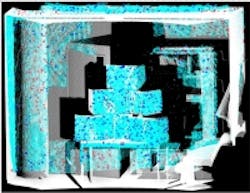How accurate is the Kinect?
An assistant professor at the Faculty of Geo-Information Science and Earth Observation of the University of Twente (Enschede, The Netherlands) has written a technical paper that analyses the accuracy and resolution of the depth data from the Microsoft Kinect sensor.
Consumer-grade range cameras such as the Kinect have the potential to be used in mapping applications, but to realize their potential, some insight into the geometric quality of the data that they acquire is essential.
Since the Kinect was only released in November 2010, little information about the quality of the data obtained from it is available, while similar range sensors based on the time-of-flight measurement principle have been investigated more thoroughly.
To rectify that matter, Professor Kourosh Khoshelham undertook an investigation to determine the accuracy and resolution of Kinect depth data for indoor mapping applications.
In his work, he discovered that the random error of depth measurement increases with increasing distance to the Kinect sensor, and ranges from a few millimeters up to about four centimeters at the maximum range of the sensor. He also found that the depth resolution of the device decreases quadratically with increasing distance from the sensor.
Dr. Khoshelham’s paper “Accuracy and Resolution of Kinect Depth Data for Indoor Mapping Applications” can be found here.
Interested in reading how others are using the Kinect? Here’s a compendium of five news stories on the Kinect that Vision Systems Design has published over the past six months.
1. Microsoft’s Kinect helps keep surgery sterile
Engineers based at Microsoft Research (Cambridge, UK) have developed a system based on the Microsoft Kinect that allows surgeons to manipulate images in the operating theater.
2. 3-D algorithms combine with Kinect to track objects using continuous point cloud data
During an internship at robot hardware and software developer Willow Garage (Menlo Park, CA, USA), Ryohei Ueda from the JSK laboratory at the University of Tokyo (Tokyo, Japan) has developed 3-D algorithms that can be used with the Microsoft Kinect to help computer systems track objects in a scene in real time.
3. Kinect helps stroke victims recover manual agility
Researchers at of Southampton University (Southampton, UK) and Roke Manor Research (Romsey, UK) have developed a biomechanics system using Microsoft's Kinect that can help stroke patients recover manual agility.
4. Kinect system tracks household objects
Two researchers from the Department of Computer Science at the University of Virginia (Charlottesville, VA, USA) have developed algorithms that can be used with Microsoft Kinect hardware to locate and track household objects.
5. 3-D image reconstruction uses multiple structured-light cameras
Microsoft researchers, working with engineers at the University of Science and Technology of China and Texas A&M University (College Station, TX, USA), have developed new software that has enabled them to reconstruct a 3-D scene from multiple structured-light based cameras.
-- by Dave Wilson, Senior Editor, Vision Systems Design
